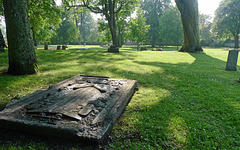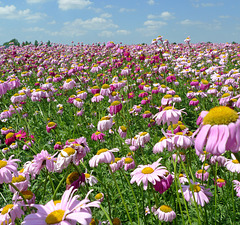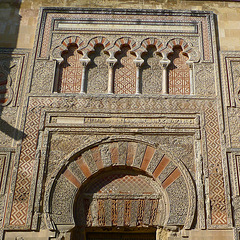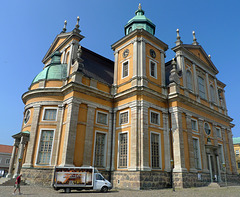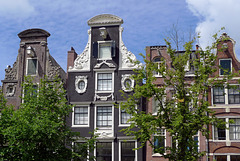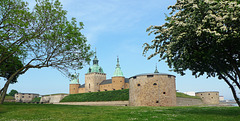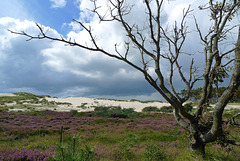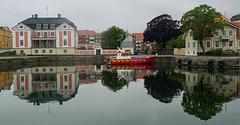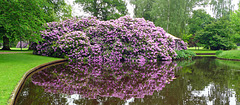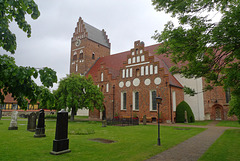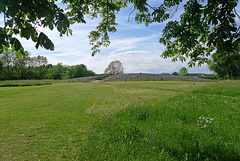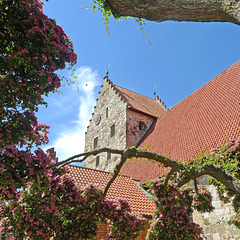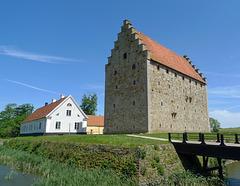Jaap van 't Veen's photos
Sweden - Kalmar, Gamla Kyrkogården
| |
|
|
|
Gamla Kyrkogården (Old Cemetery), located in the former medieval city of Kalmar, is dating back to the first half of the 13th century. It is the oldest Christian burial ground in Kalmar. At the square of the Old Town stood the Bykyrkan (Village Church) and in connection with it the cemetery was laid out.
The Village Church was blown up during the 1670s, when the whole city of Kalmar was moved to it´s present place on Kvarnholmen. Gamla Kyrkogården kept in use till the 1860’s and remained at its original place, till the South Cemetery, close to Kalmar Castle, was ready
Several old gravestones can still be seen in the cemetery, many with unusual motifs and forms. The place where the old church stood is marked with a memorial plaque as well as stones that show where the foundation stood. There are tombstones from the 17th and 18th centuries and standing gravestones from the 19th century. Several of these stones were locally made, using limestone from Öland. Memorial crosses of cast iron became common in the middle of the 19th century
One of the most remarkable gravestones (see first PiP) shows a knight (Christopher Andersson Grip) and his wife; both seem to be beheaded. According to a plaque they died in 1588 and 1599.
Nederland - Tholen, Perzische Margriet of Pyrethru…
| |
|
|
|
Pyrethrum was a genus of several Old World plants now classified as Chrysanthemum coccineum or Tanacetum coccineum, which are cultivated as ornamentals for their showy flower heads.
Pyrethrum continues to be used as a common name and is also the name of a natural insecticide made from the dried flower heads of Chrysanthemum coccineum.
The ‘Perzische Margriet’ (Persian chrysanthemum) is a perennial plant native to Caucasus and looks somewhat like a daisy. It produces large white, pink or red flowers.
Picture: field of 'Perzische Margriet' between Sint-Maartensdijk en Scherpenisse ont he island of Tholen. .
Spain - Córdoba, Mezquita
| |
|
|
|
Decorations above one of the entrance gates - Puerta de la Concepción Antigua - of the Mezquita in Córdoba.
Sweden - Kalmar domkyrka
| |
|
|
|
‘Kalmar domkyrka’ (Kalmar Cathedral) is located in the heart of the new city and dominates the central square ‘Stortorget’. According to the renaissance ideals of the mid 17th century the church and the town hall were places across from each other at the square. The new fortified city - built on the island ‘Kvarnholmen’ - was completed in the year of 1658. Two years later the construction of the cathedral started, but due to several interruptions it was finished in 1703. It has been built in a Scandinavian variant of baroque style with richly decorated facades and pilasters of limestone.
The interior of the church - remarkable bright - is laid out according to Evangelical Lutheran tenets with a focus on the main altar. This baroque altar was designed in 1704 and depicts the Trinity: Father, Son and Holy Spirit. The interior shows beautiful furnishings and fixtures with graves, epitaphs and a sculpted pulpit from the mid 17th century. In the center of the ‘domkyrka’ hangs a brass chandelier with 36 arms.
Nederland - Amsterdam, Grachtengordel
| |
|
|
|
Amsterdam has more than one hundred kilometers of canals, about 90 islands and 1500 bridges. The ‘Grachtengordel’ (Canal Ring Area) does exist of the Singel - in the Middle Ages a moat around the oldest parts of the city - and the main canals Herengracht, Prinsengracht, and Keizersgracht. These three canals - dug in the 17th century during the so called Dutch Golden Age - form a concentric belt around the city.
The area around the city's main canals is an international icon of urban planning and architecture, which is still intact after four centuries. The area is known for its small bridges going over the canals and 17th-century canal homes. UNESCO added the Canal Ring Area in August 2011 to the World Heritage List.
Pictures:
main photo: façades of canal houses along de Prinsengracht, nearby Brouwersgracht
note 1: Herengracht
note 2: Prinsengracht
note 3: Keizersgracht
For more information: www.canalsamsterdam.com
Spain - Andalusia, Montoro
| |
|
|
|
Montoro is a typical Andalusian ‘pueblo blanco’ (white village) which is perched on a bluff above the Rio Guadalquivir with its whitewashed houses. It is a quite historical town, with an Iberian, Greek, Roman and Moslem past. In the Roman era the town was called Epora. It became an important fortified town under the Moors; after changing hands between Moorish and Castilian kingdoms the town was finally conquered by King Fernando III and became its present name Montoro.
Montoro offers some fine historical sights (churches and city hall) around or nearby the central square Plaza de España. Another emblematic sight is the bridge over the Guadalquivir, connecting the old town with the neighbourhood of El Retamar. Its construction began in 1498 and took more than fifty years. The women of Montoro donated their jewelry and goods to raise money for the construction. That is why it is known as ‘Puente de las Donadas or Puente de las Donadas (Bridge of Donations or Damsels).
Sweden - Kalmar, Kalmar Slott
| |
|
|
|
The first defensive constructions on the place of the present Kalmar Castle were built in the 12 and 13th century. Kalmar Castle was an important fortification and known as the key to the kingdom because of its strategic location. The Swedish-Danish border was located only a short distance to the south, because the provinces of Scania and Blekinge were Danish territory for a long time.
Kalmar Castle became its current design during the 16th century by several Vasa kings. They turned the medieval fortress into a renaissance castle.
The castle suffered heavy damage during the Kalmar War of 1611-13 and was badly damaged by a fire in 1642. Repairs were begun but from the end of the seventeenth century the castle was allowed to fall into disrepair.
In 1856 restorations were initiated restoration work at Kalmar Castle and by 1891 the castle had gained the silhouette it bears today. Early 20th century the earthworks, the moat, the bridge and the drawbridge were restored. Work continued until 1941, when the castle was once more surrounded by water. Today Kalmar Slott is one of Sweden's best preserved renaissance castles.
Nederland - Neer, Friedesse Molen
| |
|
|
|
The Friedesse Molen (Friedesse Mill) is a watermill situated along the Neerbeek, a small stream which ends in the Maas. The mill is renovated in 2002 after being out of use for more than 50 years. The mill and mill house are been built in the year of 1717, although the watermill was already mentioned in documents in 1343.
The Friedesse Mill is the only remaining mill of six mills along the Neerbeek.
After being restored and renovated the mill is used again as a flour mill. Volunteers are now operating the Friedesse Mill. See for opening hours the link below.
Sweden - Nybro, Pukeberg Glasbruk
| |
|
|
|
Pukeberg Glasbruk (Pukeberg Glass factory) is (or better was) one of Sweden’s oldest and most well-preserved glassworks. Glass has been produced here since 1871; the former factory is located in a wonderful green environment nearby the town of Nybro. It is part of the so called Glasriket (the Kingdom of Crystal), a region in the Swedish province of Småland, where hand-blown glass has been made since 1742.
Pukeberg is no longer a running factory and during my visit there were just a couple of ‘glass activities’ in the former factory buildings like a glass blower, a large glass shop and a smaller museum. Pukeberg is becoming more and more a centre for new (glass) activities.
Nederland - Bergen aan Zee, Noordhollands Duinrese…
| |
|
|
|
White sand of the dunes and blooming heather in the ‘Noordhollands Duinreservaat’ (North-Holland Dune Reserve). This reserve is controlled by the provincial water company and stretches from Bergen aan Zee till the North Sea Canal nearby Wijk aan Zee. The area is open to the public (walker and cyclist), however an admission ticket is needed.
The photo is taken along the Verspijckweg (a bike lane through the dunes) just north of the village of Bergen aan Zee.
Sweden - Karlskrona, Kungsbron
| |
|
|
|
In the past - when the most frequently way to visit Karlskrona was by water - Kungsbron (Kingsbridge) was the front door to the city. The residents of Karlskrona once gathered at Kungsbron to welcome kings and other guests.
The pink and white building is the residence of the county governor. The view from Kungsbron over the nearby islands is enchanting.
Nederland - Bergen, Ruïnekerk
| |
|
|
|
The Ruïnekerk (Ruin Church) is dating back to the second quarter of the 15th century and was built on the site of a smaller pilgrimage chapel, which was built after the so called ’Miracle of Bergen’ in 1422.
At time of the construction the church was the largest in the province of North-Holland. Originally it was a Gothic church, dedicated to Peter and Paul. In 1574, during the Eighty Years War against Spain, the church was looted and burned down by Dutch protestants troops ‘De Geuzen’. The tower was lost completely, but the rulers of Bergen prevented the eventual destruction of the other remains, parts of the outer walls of the nave and the walls of the choir with its flanking chapels. The choir was rebuilt in 1594-1597 to serve as a reformed church.
Nowadays the church is still used for religious services and other cultural events. The Ruïnekerk is the landmark of the village of Bergen, located right in the heart of the town.
Sweden - Ronneby, Brunnspark
| |
|
|
|
At the end of the 19th century Ronneby Brunn was a famous spa. People went here for the nourishing mineral water as well as the beautiful surroundings. The beautiful Brunnspark is a spa park with a history that goes back to 1705, when a Danish landscape designed the 100 hectares large park with wooden buildings.
n the 1980s a famous Swedish landscape architect planned and designed the restoration of the park by adding new elements. The ‘spa buildings’ are also renovated and host modern companies.
In 2005 the park was named Sweden’s most beautiful park; one year later Brunnspark came fourth in the “Europe’s most beautiful park” competition.
We were lucky (early June) seeing all the flowering rhododendrons.
Sweden - Åhus, Sankta Maria kyrka
| |
|
|
|
Sankta Maria kyrka (St. Mary"s Church) was built in the 12th century - and enlarged a century later - in a style like the German brick Gothic; it is one of the oldest buildings of Åhus. The church was enlarged a century later and has been restored and rebuilt several times. The bell tower was added in late Middle Ages.
The interior with the blue coloured pews is quite large and offers several treasures. The retable has beautiful carvings and offers after a restoration its original colours. The Renaissance style pulpit dates from the 1600s and is decorated with images of St. Paul and the four evangelists.
Nederland - Deurne, Groot Kasteel
| |
|
|
|
Deurne Castle, locally known as 'Groot Kasteel' or 'Nieuw Kasteel' (Great Castle or New Castle) was most probably built around 1397 by Gevard van Doerne. The castle was originally a square building with several turrets. Due to the thickness of the walls it is not likely that the building had a real military purpose. It is located in the swampy valley of a stream called the Vlier. It is more or less surrounded by the remains of a moat.
In the 16th century the building was burned down and decades later plundered by Spanish troops. Mid 17th century the castle was enlarged. In 1759 the castle was bought by Theodorus de Smeth. His family also thoroughly rebuilt the castle and would own it until WW2.
During the liberation of Deurne in 1944 the castle suffered heavily from allied fire and there were only remains left.
Nowadays the ruin - which was consolidated in 2002 - of ‘Groot Kasteel Deurne’ is used by a youth association.
Sweden - Kivik, Kungagraven
| |
|
|
|
Kungagraven (King's Grave) is a grand Nordic Bronze Age double burial, about 3.500 years old. Thee mound has a diameter of 75 metres. The site has been used as a quarry and its stones carried off for other uses. The cists are adorned with petroglyphs carved into the stones.
In 1748 two farmers discovered the 3.25 meter tomb constructed with ten slabs of stone. Several years passed before it was discovered that the slabs of stone in the tomb were adorned with petroglyphs. Between 1931–1933 a thorough excavation was undertaken and the remains of a Stone Age settlement were found under the massive cairn.
The mound has been named Kungagraven due to its size, long before it was known to contain two burials. The restoration of the site was based on etchings from the 18th century and conjecture. A new chamber was constructed out of concrete and a tunnel extended into the cists.
It is possible for visitors to enter the tomb and to see the engraved stones.
Sweden - Simrishamn, Sankt Nicolai kyrka
| |
|
|
|
Sankt Nicolai kyrka (St. Nicholas’ Church) is dating back to the 12th century and was first mentioned in 1161. The nave was added during the next century. The church - named after Sankt Nicolaus, the patron saint of the sea men - was originally a chapel for fishermen and as the town expanded, has been built on substantially. It became its present size at the end of the Middle Ages.
The exterior of the church was changed in 1953 when the white plaster was knocked down and the original facade of quartzite appeared, something that gives the church its external character.
The church is located in the centre of the city of Simrishamn, next to the Stortorget, the central square. The flowers are from a Crimson Hawthorn.
Sweden - Glimmingehus slott
| |
|
|
|
Glimmingehus is considered to be the best-preserved medieval castle in Sweden.
The construction of the castle was started in 1499 (completed in 1505) knight Jens Holgersen Ulfstand, who apparently terrorised the farmers of the region in the service of the king of Denmark. Sweden’s province of Skåne was part of Denmark at the time.
The impressive castle is more of a ‘keep’. Glimmingehus contains many defensive arrangements of that era, such as parapets, false doors and dead-end corridors, 'murder-holes' for pouring boiling pitch over the attackers, a moat and drawbridge.
The castle is 30 meters long, 12 meters wide; the highest point comes to almost 26 meters. The lower part of the castle's stone walls are 2.4 meters thick and the upper part 1.8 meters.
Glimmingehus looks imposing, just a big stone box located on the vast fields of Österlen.
Nowadays the castle is a museum; on site there are also a restaurant with medieval dishes, a shop and a coffee house.
Jump to top
- ipernity © 2007-2024
- Help & Contact
|
Club news
|
About ipernity
|
History |
ipernity Club & Prices |
Guide of good conduct
Donate | Group guidelines | Privacy policy | Terms of use | Statutes | In memoria -
Facebook
Twitter

